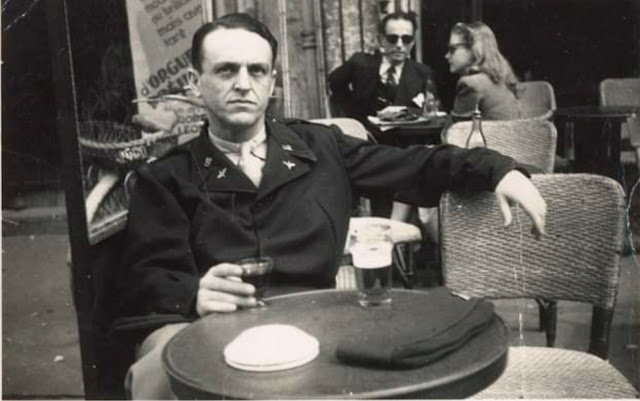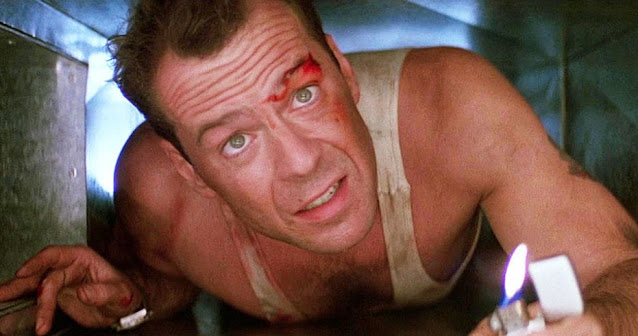Glasnost and Perestroika Failed to Sink "The Hunt for Red October"
When Tom Clancy published The Hunt for Red October in 1984, the Soviet Union was popularly known as the “evil empire” – in the words of then-President Reagan. But by 1988 and 1989, when the movie version of The Hunt for Red October was in production, huge changes were taking place in the world order, which necessarily influenced the approach the filmmakers took to the material.
Alec Baldwin explained, “With glasnost and the things going on in Eastern Europe, we were forced to frame Red October very deliberately in the early ‘80s, when the Soviet Union was this ‘evil empire’ that people wanted to defect from. You would think that Americans would always lead the way in democracy, but we can’t be so sure of that anymore. Democracy seems to have more of a soul, a scope and a passion over there now.”
 |
| Sean Connery as 'Captain Marko Ramius', Alec Baldwin as 'Jack Ryan' and Scott Glenn as 'Rear Admiral Bart Mancuso' in The Hunt for Red October |
Producer Mace Neufeld recalled, “While we were dealing with what you do in production, in the back of our minds was glasnost and perestroika. Here we were, making a Cold War movie, and there was no more Cold War.”
The Cold War began to wind down in 1985, when newly elected Soviet General Secretary Mikhail Gorbachev introduced a program of reforms called perestroika. Perestroika was intended to combat widespread corruption and abuse of privilege by the Communist Party officials running the country. To that end, Gorbachev instituted a relaxation of censorship called glasnost. By cultivating a spirit of intellectual and cultural openness which encouraged public debate and participation, Gorbachev hoped to increase the Soviet people’s support for and participation in perestroika. Glasnost was intended to liberalize freedom of the press gradually, and to allow for greater freedom of dissent. In reality, glasnost was far more successful than Gorbachev had intended. With greater access to information, Soviet citizens began to realize that the sunny picture the government-controlled media had painted of life in the USSR was false, and this played a key role in the collapse of the Soviet Union.
 |
| Perestroika-era Soviet propaganda poster, circa 1986 |
When Gorbachev ascended to power in 1985, the Soviet economy was on the brink of collapse. The country had an economic growth rate close to 0%, and military spending consumed 25% of the country’s gross national product – at the expense of the Soviet people, most of whom lived bleak lives of shortages, restrictions and deprivation. To restructure the Soviet economy before it completely collapsed, Gorbachev announced that he was going to redirect the country’s resources from costly Cold War military commitments to more profitable areas in the civilian sector. In pursuit of that goal, Gorbachev offered major concessions to the US on the levels of conventional forces, nuclear weapons, and policy in Eastern Europe. Though many US Soviet experts and administration officials doubted that Gorbachev was serious about winding down the arms race, the new Soviet leader eventually proved more concerned about reversing the Soviet Union’s deteriorating economic condition than fighting the arms race with the West. In 1988, the Soviets officially declared that they would no longer intervene in the affairs of allied states in Eastern Europe. In 1989, Soviet forces withdrew from their disastrous ten-year war in Afghanistan. In December 1989, Gorbachev and President George H.W. Bush declared the Cold War officially over at a summit meeting in Malta.
 | |
|
But Gorbachev’s well-meaning reforms came too late. By 1989, the Soviet alliance system was on the brink of collapse, and the Communist leaders of the Warsaw Pact states were losing power. By February 1990, the Communist Party was forced to give up its 73-year-old monopoly on power. As a result, competitive elections were held over the next few months throughout the USSR’s member states, which in many cases brought reformers and ethnic nationalists into power. By December of the next year, the union-state had dissolved, breaking the USSR up into 15 separate independent states.
Fortunately – since The Hunt For Red October had a March 1990 release date – the filmmakers had anticipated the wave of change that overtook the USSR. Producer Mace Neufeld pointed out that “in the end, we were ahead of the game,” because Captain Ramius’ line, “A little revolution now and then is a good thing, don’t you think?” was actually written a year and a half before the movie’s release. Director John McTiernan also felt the film fit squarely into the path of history. “We added a few lines in which we gently tried to hint that this incident, or some incident like it, might have been part of what shocked the Soviet hierarchy into changing,” McTiernan revealed.
In fact, McTiernan admitted that he had subscribed to a “secret agenda” while making Red October. “You may think this sounds silly, but I saw the piece as a second Russian revolution,” he said. “To me, the emotional heart of the movie comes when the sailors sing their national anthem.”
By the time the film was finished, director John McTiernan had spent a lot of time observing the Navy military complex, and had gained a real respect for the the fighting men he’d met. Afterward, McTiernan mused, “One thing I found most remarkable was that when glasnost began happening, it was the Navy guys I met who were the most excited about the possibility of a world where we did not need a nuclear arsenal. They have had to think about the unthinkable. They are far more aware of the horrors of a nuclear war than we give them credit for – and far more willing to move on. I found that inspiring.”
William H. Honan, “Can the Cold War Be a Hot Topic for a Movie?” New York Times, 2/25/90
“Will History Sink Red October?” Los Angeles Times, 3/1/90
Shari Roman, “Leading Man Alec Baldwin: The Hunt for Red October,” Movies, 3/90
Mark Cotta Vaz, “The Thrill of the Hunt,” Cinefex, 5/90
Alan L. Gansberg, “Mace Neufeld: The Hunt for a Hit Movie,” Hollywood Reporter, 3/18/91


Comments